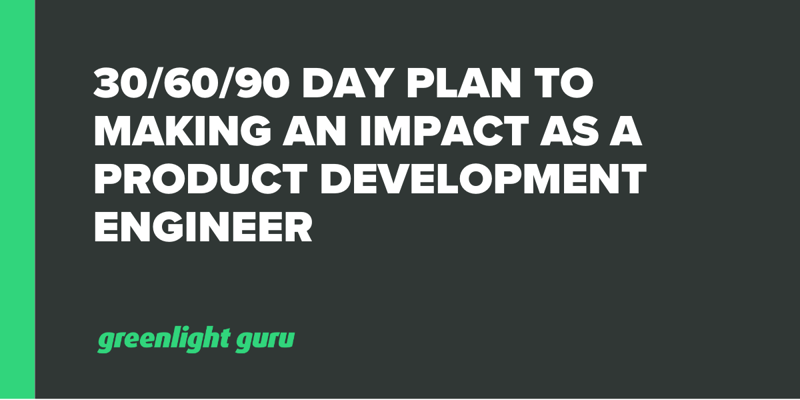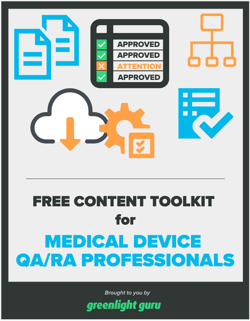30/60/90 Day Plan to Making an Impact as a Product Development Engineer

To say product development engineers are important to medical device development would be the understatement of the century.
The impact these folks have is undeniable, and they shoulder a huge amount of responsibility for ensuring a product is designed safely and effectively. That’s why we’re bringing you a 30, 60, and 90 day roadmap to making an impact as a product development engineer.
Product Development Engineer at 30 Days: Understanding the Product
The first 30 days as a new product development engineer will be, for lack of a better word, a whirlwind. There’s the usual new-job rigamarole: meeting your new boss, identifying the power centers that be, and trying your best to remember everyone’s name.
Don’t get me wrong, establishing these professional, cross-functional relationships will prove to be important; however, as a new medical device engineer, your number one goal is to understand the product. This means learning the answers to questions like:
-
What is the history of the device or design?
-
What problem is it intended to solve?
-
Who are the users and what are their needs?
If these questions may seem elementary, that’s because they are. This is a foundational time, and as you become familiar with the product, it serves as a solid base as you piece together scaffolding for more intricate details like design controls and how the product fits within the realm of your QMS.
That said, you can bet there’ll be high expectations. After all, you have the blueprints - now it’s time for you to level up.
To do so, you’ll need to focus on two vital documents: the design traceability matrix and risk matrix. These two assets are your resources for growth as a product development engineer; not just as references for education, but for practicing and improving your documentation skills.
Fair warning, these documents will feel like a pain at first. Why wouldn’t it? You got into this field to make life-saving products, not fill out paperwork! But, I assure you, it will help you in the long run.
Try to remember that documentation isn’t a checkbox activity, it’s the roadmap for everyone who comes after you, and the only way to get credit for your work when things go right, and the most efficient way to fix problems when things go wrong. It’s also essential for building true quality medical devices.
Product Development Engineer at 60 Days: Adding Value to Product and Process
You’ve learned the inputs and outputs of the product. You’ve delved into design controls and documentation. You’ve developed good working relationships with QA and RA departments. You even figured out where the best bathrooms in the building are. Now it’s time to turn our attention to making an impact with your work.
How do we accomplish this? Much like the first 30 days, it happens through curiosity and asking questions. However, now the inquiries should become more pointed and probing. You’ll be looking at the work already done, both by yourself and others, and asking questions like:
-
Are we building the right product?
-
Are we building it the right way?
-
Are we being efficient?
-
Are there any issues that will prevent us from delivering the product?
You may be nearing verification and validation testing to conclude whether the product is truly meeting the user’s needs. You might be interviewing doctors in the field or patients who are using the devices in clinical studies.
You may be charged with choosing suppliers and vendors for your required materials. And you will almost definitely be preparing documents that will be used for upcoming submissions. Whatever the method, your task will be about evaluating what has been done and figuring out how it can be done better.
While these may sound slightly antagonistic, this is why they hired you: to improve and demonstrate the value of the product. Bringing safer devices to market faster requires looking for hazards and performing risk assessments - that’s just part of the job.
However, when critiquing others' work it’s equally important to consider not just what you say, but how you say it. Workplace culture is hugely important, and in your second month on the job you should be adding value to your working relationships, too. You can still communicate your critique, as long as it’s done with empathy, radical candor, and a sincere gratitude to your team.
Product Development Engineer at 90 Days: Final Handoff to RA and Manufacturing
Bringing safe and effective medical devices to market is difficult work and requires minds as bright as yours to do so. After all, these products can vastly improve the quality of life for patients in a real and meaningful way. So if you’ve made it this far, some congratulations are in order!
Before any celebrations begin, you’ll need to focus on the all-important task of getting your product over the finish line. This phase is a culmination of all the work that came before. But because the product development phase is coming to an end, what will really define success for a product development engineer is a successful handoff to both the regulatory team and your manufacturing counterparts.
For the regulatory team you’ll be compiling documentation, ensuring you’ve followed design controls, and verifying no new risks have arisen during the final clinical trials and testing. By this point, your documentation skills should be sharp as a tack.
Keep in mind documentation is not just about what you document, but how you communicate that information. The best engineers know there’s a difference between robust and verbose documentation.
Handing off to manufacturing is primarily about the design transfer process. This is how you provide all the information to your manufacturing team so they can consistently make your product correctly.
Effective design transfer practices should occur throughout the product development phases. If your team has followed this best practice, your handoff to manufacturing should be smooth. You’ll be engaging in activities like demonstrating successful design verification and validation and ensuring your device master record (DMR) is complete and accurate.
Looking Ahead for Product Development Engineers
I won’t make you wait any longer. If you’ve successfully brought a device to market, it’s time to celebrate. And as a forward-thinking, accomplished, and confident product engineer, this means three things:
-
Partying down with your awesome team!
-
A stirring and workplace-appropriate karaoke song choice!
-
Thoughtful consideration and planning for post-market activities!
No product ends at release, and neither does the work for a medical device company. Product development engineers like yourself may be kept on a product as a sustaining engineer to review design history files and risk controls, or transferred to a new project altogether.
No matter what stage of your product development engineer career you’re in, Greenlight Guru has the tools you need. That’s because we offer the only QMS software designed by medical device professionals specifically for medical device professionals.
Our comprehensive, out-of-the-box solution is based on the latest FDA and ISO standards, as well as best practices of medical device manufacturers who lead the industry in production of high-quality devices.
If you’re ready for your free personalized demo, click here today!
Looking for a design control solution to help you bring safer medical devices to market faster with less risk? Click here to take a quick tour of Greenlight Guru's Medical Device QMS software
Etienne Nichols is the Head of Industry Insights & Education at Greenlight Guru. As a Mechanical Engineer and Medical Device Guru, he specializes in simplifying complex ideas, teaching system integration, and connecting industry leaders. While hosting the Global Medical Device Podcast, Etienne has led over 200...
Related Posts
What is a Traceability Matrix and How Do I Create One for My Medical Device?
Best Practices for an Effective Medical Device Design Transfer Process
Top 50 Medical Device Product Design and Development Companies
Get your free resource
Bonus Resource: Content Toolkit for Product Development Engineers


.png?width=180&name=content%20toolkit%20cover%20-%20PD%20copy%20(1).png)








